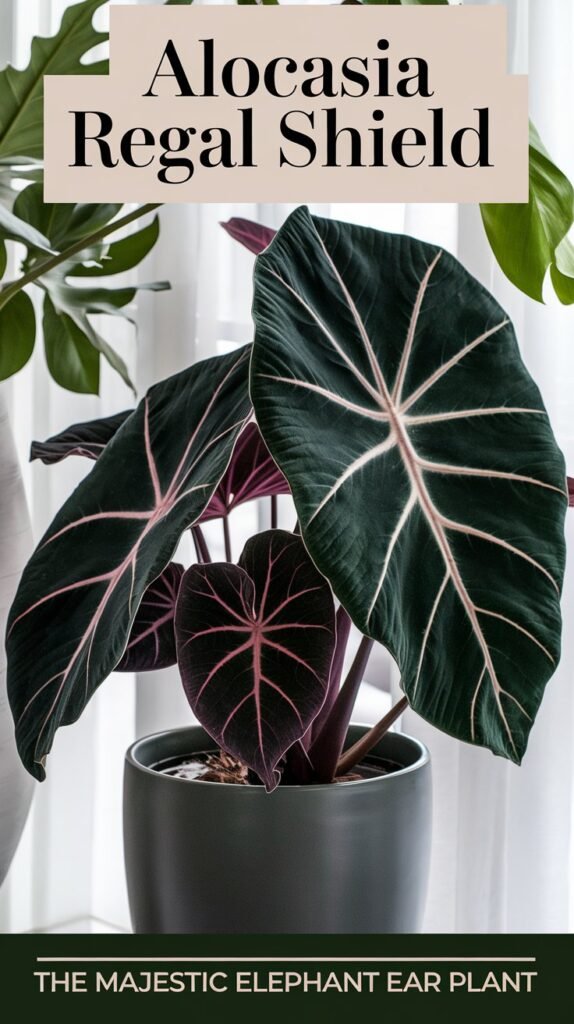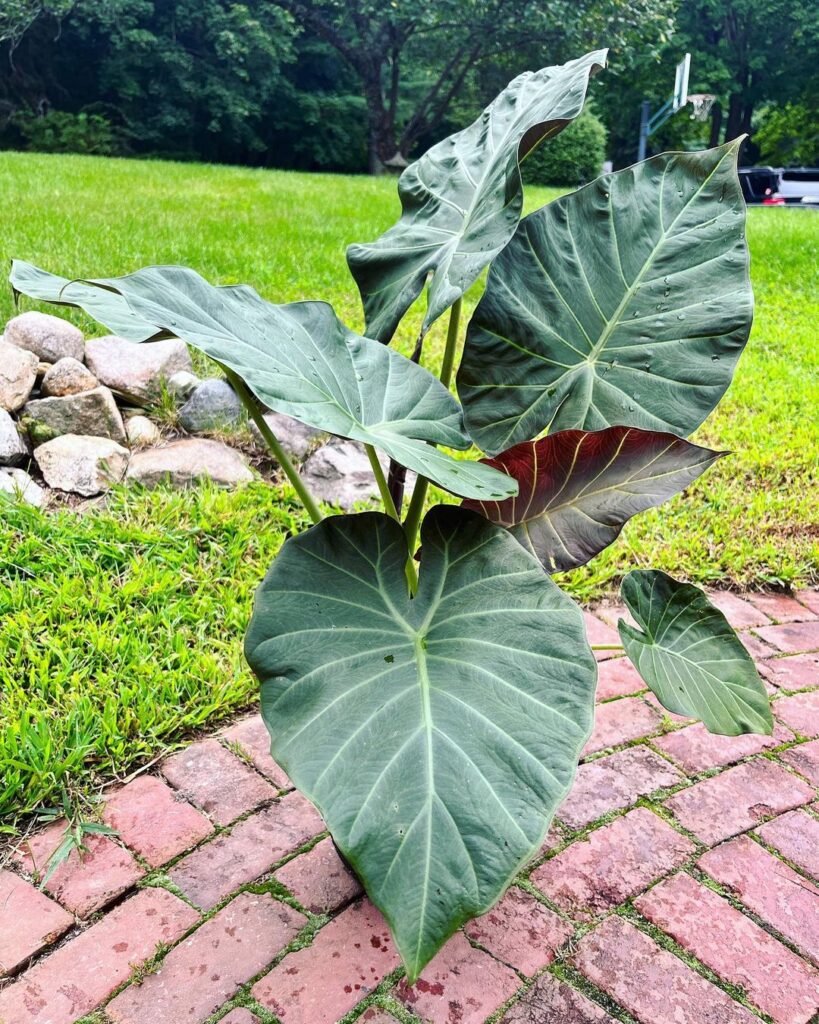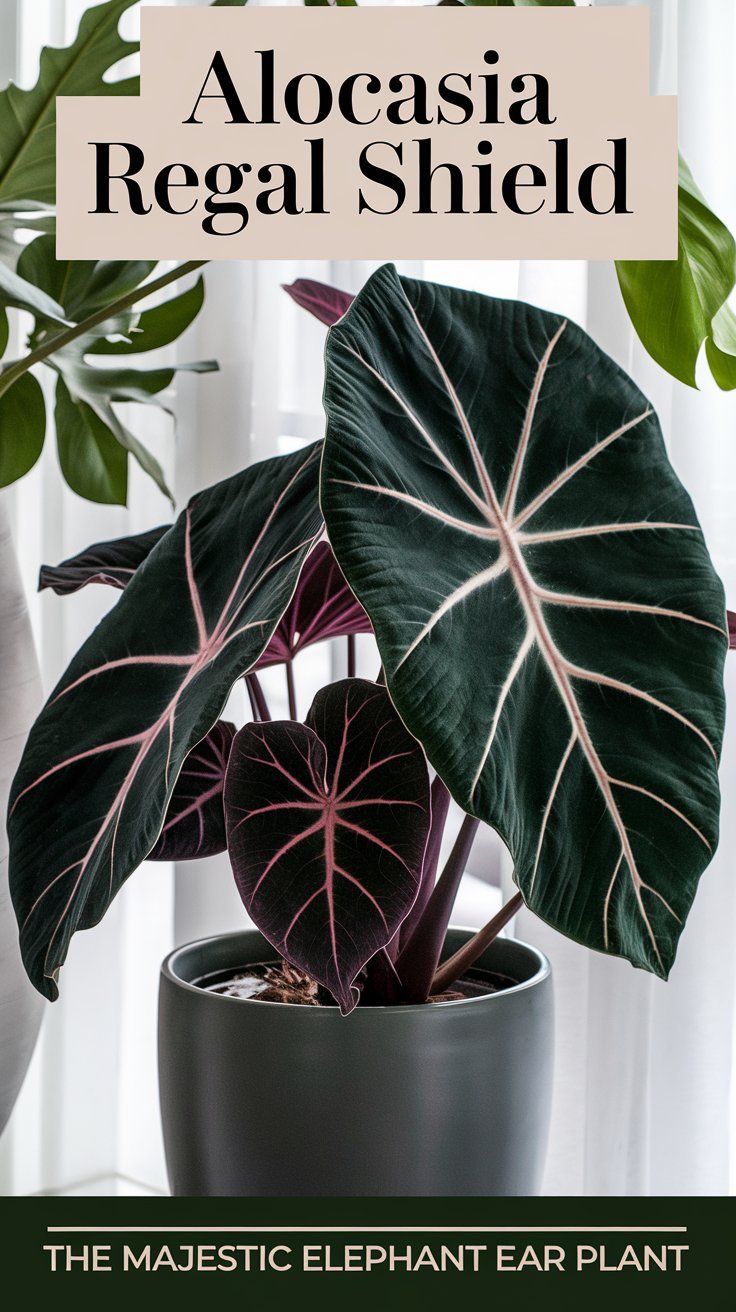Discover the majestic Alocasia Regal Shield! Learn expert care tips, propagation techniques and troubleshooting for this stunning tropical plant. Perfect for 2024’s indoor jungle trend.
The Alocasia Regal Shield, with its large, dark green leaves and striking silvery veins, is a showstopping tropical plant that brings a touch of exotic elegance to any indoor space. This impressive member of the Aroid family, also known as Elephant Ear, has become increasingly popular among plant enthusiasts for its dramatic foliage and relatively easy care requirements. In this comprehensive guide, we’ll explore everything you need to know to help your Alocasia Regal Shield thrive in 2024 and beyond.
As a tropical plant specialist with over a decade of experience cultivating rare Aroids, I’m excited to share my insights on the magnificent Alocasia Regal Shield. Let’s dive into the world of this regal beauty and discover how to make it a thriving centerpiece in your indoor jungle!
Understanding the Alocasia Regal Shield

Before we delve into care instructions, let’s get to know this plant better:
Scientific Name: Alocasia ‘Regal Shields’ (hybrid of Alocasia odora and Alocasia reginula) Common Names: Elephant Ear, African Mask Plant Native Region: Hybrid cultivar, parent species from Southeast Asia Growth Habit: Upright, clumping Maximum Size: 4-5 feet tall and 2-3 feet wide
Why Choose Alocasia Regal Shield?

- Striking foliage with large, dark green leaves and silvery veins
- Relatively easy care for such an impressive plant
- Air-purifying qualities
- Dramatic tropical aesthetic for indoor spaces
- Conversation starter and focal point in any room
Now, let’s explore how to care for your Alocasia Regal Shield to ensure it thrives in your home.
Comprehensive Care Guide for Alocasia Regal Shield
1. Light Requirements
Why It’s Important: Proper lighting is crucial for maintaining the plant’s rich coloration and promoting healthy growth.
How to Provide:
- Place in bright, indirect light
- Avoid direct sunlight, which can scorch the leaves
- Can tolerate lower light conditions, but growth may slow
2024 Trend: Smart grow lights with spectra tailored for tropical plants are gaining popularity for optimal indoor growth.
Pro Tip: Rotate the plant quarterly to ensure even growth on all sides.
2. Watering Needs
Why It’s Important: Proper watering prevents root rot while ensuring the plant has enough moisture.
How to Water:
- Keep soil consistently moist but not waterlogged
- Allow top inch of soil to dry between waterings
- Reduce watering in winter when growth slows
2024 Update: Self-watering planters with built-in moisture sensors are becoming more sophisticated and reliable.
Pro Tip: Use filtered water or allow tap water to sit out overnight to dissipate chlorine.
3. Soil and Potting
Why It’s Important: Well-draining, nutrient-rich soil promotes healthy root development and prevents water-related issues.
Ideal Soil Mix:
- 1 part potting soil
- 1 part perlite or pumice
- 1 part orchid bark or coconut coir
2024 Innovation: Biochar-enriched potting mixes are gaining traction for their water retention and nutrient-holding properties.
Pro Tip: Repot every 2-3 years or when the plant outgrows its current container.
4. Temperature and Humidity
Why It’s Important: Mimicking tropical conditions ensures optimal growth and prevents stress.
Ideal Conditions:
- Temperature: 65-80°F (18-27°C)
- Humidity: 60% or higher
2024 Trend: Micro-climate cabinets for tropical plants are becoming more accessible for home use.
Pro Tip: Group with other tropical plants or use a pebble tray to increase local humidity.
5. Fertilization
Why It’s Important: Proper nutrition supports lush foliage growth and overall plant health.
How to Fertilize:
- Use a balanced, water-soluble fertilizer monthly during growing season
- Dilute to half-strength to prevent fertilizer burn
- Pause fertilization in winter
2024 Research: Studies on biostimulants are showing promising results for enhancing plant growth and stress tolerance.
Pro Tip: Flush the soil every few months to prevent salt buildup from fertilizers.
6. Pruning and Maintenance
Why It’s Important: Regular grooming keeps the plant looking its best and promotes healthy growth.
How to Prune:
- Remove yellowing or damaged leaves at the base
- Wipe leaves gently with a damp cloth to remove dust
- Trim any leggy growth to maintain shape
2024 Update: New pruning tools designed specifically for large-leaved plants are hitting the market.
Pro Tip: Use clean, sharp tools to prevent disease transmission when pruning.
7. Propagation
Why It’s Important: Propagation allows you to multiply your plant collection or share with friends.
How to Propagate:
- Division of offshoots during repotting
- Stem cuttings (less common, but possible)
2024 Trend: Tissue culture kits for home use are making rare plant propagation more accessible.
Pro Tip: Spring is the best time for propagation when the plant is entering active growth.
8. Pest and Disease Management
Why It’s Important: Early detection and treatment prevent major infestations and plant damage.
Common Issues:
- Spider mites
- Mealybugs
- Root rot
2024 Innovation: Biological pest control methods using beneficial microorganisms are becoming more refined and effective.
Pro Tip: Regularly inspect the undersides of leaves and leaf joints for early signs of pests.
Troubleshooting Common Alocasia Regal Shield Problems
- Yellowing Leaves: Often indicates overwatering or poor drainage. Adjust watering schedule and check soil composition.
- Drooping Leaves: Can be a sign of underwatering, low humidity, or temperature stress. Adjust care accordingly.
- Brown Leaf Tips: Usually caused by low humidity or mineral buildup from tap water. Increase humidity and consider using filtered water.
- Slow Growth: Normal in winter or low light conditions. Ensure adequate light and resume regular care in spring.
- Leaf Loss: Some leaf shedding is normal, especially in winter. Excessive loss might indicate stress from improper care.
Styling Your Alocasia Regal Shield
The Alocasia Regal Shield makes a stunning focal point in any room. Here are some styling ideas for 2024:
- Minimalist Contrast: Place against a white wall in a sleek, modern pot for dramatic effect.
- Tropical Oasis: Group with other large-leaved tropicals like Monstera and Philodendron for a lush, jungle-like display.
- Elevated Elegance: Use a plant stand to showcase the Regal Shield at eye level.
- Natural Textures: Pair with natural materials like rattan, jute, and wood for a bohemian vibe.
Embracing the Regal Beauty
The Alocasia Regal Shield is more than just a plant; it’s a living piece of art that brings a touch of tropical majesty to your home. With its impressive foliage and relatively straightforward care requirements, it’s no wonder this stunning Aroid has captured the hearts of plant enthusiasts worldwide.
Remember, every plant is unique, and part of the joy of plant parenthood is learning to read and respond to your Alocasia’s specific needs. Don’t be discouraged if it takes some time to find the perfect balance – your efforts will be rewarded with a truly regal display of nature’s artistry.
For more information on tropical plant care and the latest horticultural research, visit resources like the International Aroid Society or your local botanical garden. Happy growing, and may your Alocasia Regal Shield reign supreme in your indoor jungle!
For more gardening tips and plant care guides, visit usagardenhub.com





One comment on “Alocasia Regal Shield : The Majestic Elephant Ear Plant”